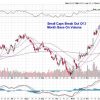Exchange-traded funds (ETFs) have become popular investment tools for individuals and institutions alike, offering diversification and convenience in a single package. As market conditions change, certain ETFs have the potential to thrive based on different factors. One such factor is the shape of the yield curve, which can have a significant impact on various sectors of the economy. In a normal yield curve environment, where long-term interest rates are higher than short-term rates, investors may look to certain ETFs that are poised to benefit from this scenario.
Two ETFs that could potentially thrive in a normal yield curve environment are the Financial Select Sector SPDR Fund (XLF) and the iShares U.S. Real Estate ETF (IYR). These ETFs focus on sectors that historically perform well when the yield curve is normal, making them attractive options for investors looking to capitalize on this particular market condition.
The Financial Select Sector SPDR Fund (XLF) is an ETF that tracks the performance of financial companies listed on the S&P 500 Index. Financial institutions such as banks typically benefit from a steeper yield curve as they borrow at short-term rates and lend at long-term rates. In a normal yield curve environment, where interest rates are incrementally rising, banks stand to gain from increased net interest margins, leading to higher profitability. The XLF ETF provides exposure to these financial companies, making it an attractive option for investors who believe that the yield curve will normalize.
Similarly, the iShares U.S. Real Estate ETF (IYR) focuses on real estate investment trusts (REITs) that invest in properties, mortgages, and real estate-related assets. REITs tend to thrive in a normal yield curve environment as rising interest rates are often accompanied by a healthy economy, leading to increased demand for real estate properties. Additionally, REITs can adjust their rental rates to compensate for rising interest costs, making them resilient to changes in interest rates. The IYR ETF offers investors exposure to a diversified portfolio of REITs, making it a potential beneficiary of a normal yield curve scenario.
Investors should note that while these ETFs have the potential to thrive in a normal yield curve environment, market conditions are subject to change, and there are inherent risks associated with investing in any security. It is crucial for investors to conduct thorough research, assess their risk tolerance, and consult with a financial advisor before making any investment decisions.
In conclusion, the Financial Select Sector SPDR Fund (XLF) and the iShares U.S. Real Estate ETF (IYR) are two ETFs that could potentially perform well in a normal yield curve environment. By understanding the relationship between the yield curve and various sectors of the economy, investors can make informed decisions when selecting ETFs that align with their investment goals and market outlook.




























